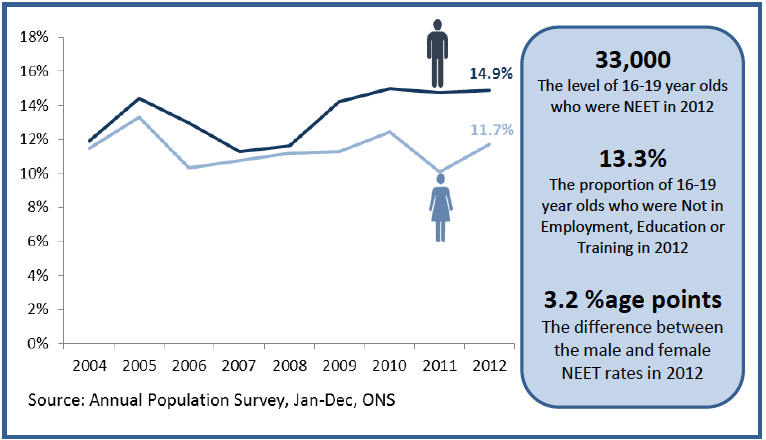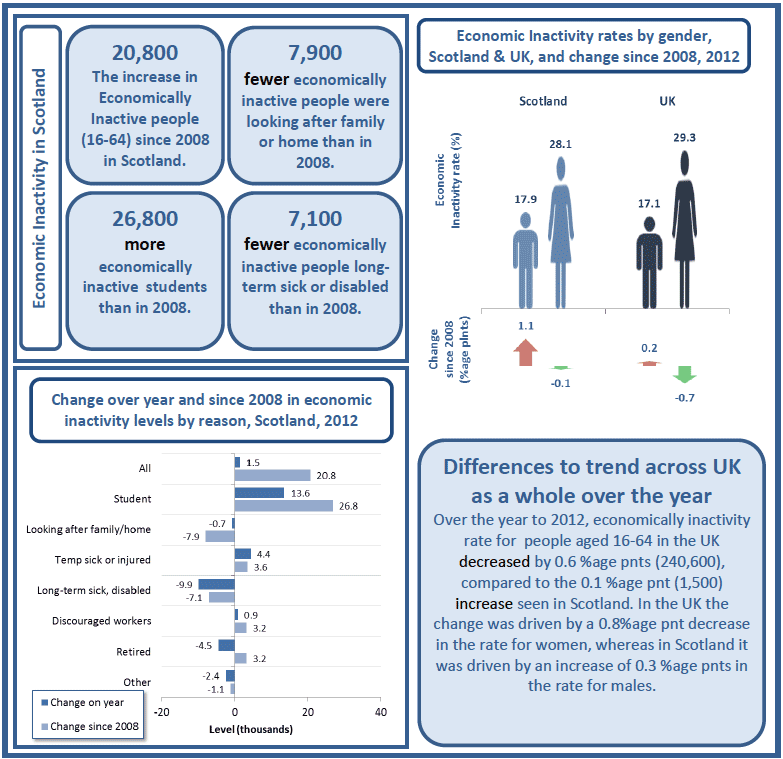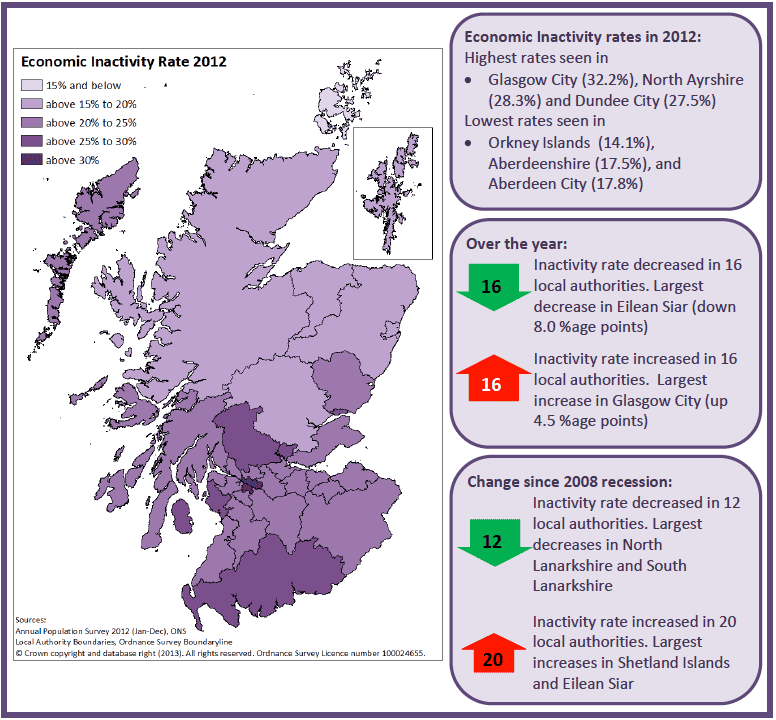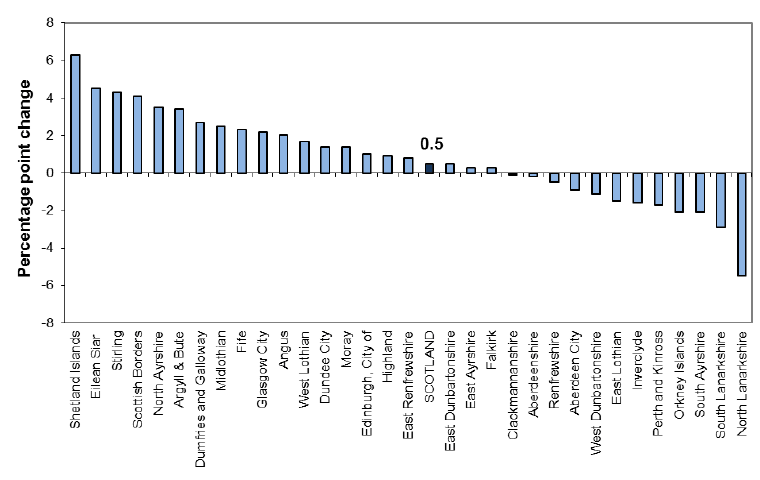Local Area Labour Markets in Scotland - Statistics from the Annual Population Survey 2012
Summary publication of results from the Annual Population Survey 2011, presenting analysis on the labour market, education and training. Results are provided for Scotland and local authority areas in Scotland.
Sub-Section B: Economic Inactivity
Economic inactivity covers individuals who are neither in employment nor unemployed. There are many reasons why people may be inactive. For example, they may have a long-term illness or disability, be studying for a qualification, staying at home to look after their family, or have retired. The economically inactive population are not part of the supply of labour. However, the labour market is dynamic, with people continuously moving between different categories. Therefore it is important to consider inactivity figures as they include those who may make up the labour supply in the future and those who were part of the labour supply in the past.
Box 8 - Economic Inactivity
Economically inactive people are not in employment, but do not satisfy the internationally agreed definition of unemployment. This group covers people without a job who:
- want a job but have not been seeking work in the last four weeks; or
- want a job and are seeking work but not available to start work in the next two weeks; or
- do not want a job.
Headline Inactivity levels and rates cover all workers aged 16-64 for both men and women. This excludes many people who would be inactive due to retirement, although still captures a large number of people in early retirement.
Figure 16: Economic Inactivity, Scotland and UK

Source: Annual Population Survey, Jan-Dec, ONS
Based on the APS:
- Over the year to January to December 2012, the economic inactivity rate for those aged 16-64 in Scotland increased by 0.1 percentage point to 23.1% (up 1,400 to 784,900), and increased by 0.5 percentage points since 2008 (up 20,800).
- In the UK, the economic inactivity rate (16-64) decreased by 0.6 percentage points over the year to 23.2% and has decreased by 0.3 percentage points since 2008.
In Scotland:
- Male inactivity levels increased over the year by 4,300, with the rate increasing by 0.3 percentage points. In contrast, female inactivity levels reduced by 2,900 over the year, with their rate decreasing by 0.1 percentage point.
- Inactivity rates tend to be higher for the 16-24 (due to higher numbers in full-time education) and the 50-64 and 65+ age groups (due to higher levels of sickness and retired people).
- o Inactivity rates for 16-24 year olds rose by 2.3 percentage points over the year to 32.8%, with the level increasing by 12,400 to 196,800, driven by increased participation in full-time education.
- o Inactivity rates for those aged 50-64 and 65+ have reduced over the year by 0.4 and 1.2 percentage points respectively. However, while the level for 50-64 year olds has also reduced (down by 2,800), the level for those aged 65+ increased (up by 17,600). The reduction in rate was due to the size of total 65+ population increased more than the 65+ inactive population.
- o The decreases in rate seen for the 50-64 and 65+ age groups were due to reductions in numbers who were inactive due to sickness or being retired. These changes are likely to be related to changes in the benefits system, the increasing state pension age and low pension annuity rates which may be causing some people to delay retirement.
- Inactivity rates for those with a disability remained unchanged over the year at 47.8%, with the level decreasing by 1,700 to 365,100.
Economic Inactivity at Local Authority level
Figure 17: Economic Inactivity by Local Authority, 2012

Source: Annual Population Survey, Jan-Dec, ONS
Table 9 in Annex A gives the economic inactivity rate for the population aged 16 to 64 in Scotland's local authorities for 2008, 2011 and 2012. A time-series back to 2004 can be downloaded from the web-tables and SNS
Chart 8 shows how economic inactivity rates have changed across Scotland's Local Authority areas since 2008
Chart 8: Percentage point change in economic inactivity, by local authority, 2008 to 2012

Source: Annual Population Survey, Jan-Dec, ONS
Between 2008 and 2012 in Scotland:
- The largest increases in inactivity rate were seen in Shetland Islands, Eilean Siar and Stirling (up 6.3, 4.5 and 4.3 percentage points respectively)
- The largest decreases in inactivity rate were seen in North Lanarkshire, South Lanarkshire (down by 5.5 and 2.9 percentage points respectively) and Orkney Islands and South Ayrshire (both down by 2.1 percentage points).
Reasons for inactivity
Respondents in the APS are asked to provide a reason as to why they are not in employment or unemployed. Figure 16 includes a chart showing change in level for reasons for inactivity since 2008 and over the year.
The largest group within the economically inactive population is those stating they have a long-term sickness or disability. The relative size of this group has reduced slowly from 30.2% in 2008 to 28.5% in 2012.
- Inverclyde, North Lanarkshire and Falkirk had the highest percentages of inactive population stating they were long-term sick in 2012, all greater than 39%.
Those looking after the family or home make up just over a fifth (20.1%) of the inactive population, having reduced slightly (1.6 percentage points) from 21.7% in 2008.
- East Ayrshire, Aberdeenshire and Midlothian had the highest percentages of those inactive due to looking after family or home, all greater than 25%.
Students are the other main inactive group, accounting for 23.3% of the inactive population in 2012. The relative size of this group had grown from 20.4% in 2008. The overall size of this group has increased by 17.2%, from 155,800 in 2008, to 182,600 in 2012.
- Only eight authorities had a higher percentage of students in their inactive population than the national average in 2012. These include the main university cities (Aberdeen, Dundee, Edinburgh, Glasgow and Stirling), as well as East Dunbartonshire, East Renfrewshire and Inverclyde.
Retired people accounted for 17.7% of the inactive population aged 16-64 in Scotland in 2012.
- 20 local authorities had higher percentages of retired inactive people than the national average. Those with the highest percentages were South Ayrshire, Eilean Siar and Perth and Kinross, (which all have populations that have higher percentages of older people). In contrast, Glasgow and Edinburgh have amongst the lowest percentages of inactive retired people, a reflection of the different age demographic within these local authorities.
More detailed information on reasons for inactivity by local authority is provided in the web tables.
Willingness to work
People who are inactive may have a willingness to work but are not available or able to do so. In 2012, 25.4% of all people in Scotland aged 16-64 who were inactive, wanted to work, compared to 24.6% in 2011. The percentage was highest in Moray, Dundee City and Aberdeen City, where the percentage of inactive people said they would like to work was 38.4%, 34.9% and 34.4% respectively. Table 10 shows the number and percentage of those who are inactive but want to work for 2008, 2011 and 2012, with a full time series available in the web-tables.
Adults who have never worked.
The APS asks those who did no paid or unpaid work if they have ever had a paid job or place on a government training scheme. As many younger people do not enter the labour market until after leaving full-time education, the chances of a person having ever worked10 is highly dependent on their age
Figure 18: Number of people aged 16 and over who have never worked, Scotland, 2004 - 2012

Source: Annual Population Survey, Jan-Dec, ONS
Figure 18 shows how the level of those who have never had a paid or unpaid job has changed between 2004 and 2011.
- The number of people aged 16 and over in Scotland who have never worked has been gradually increasing since 2004.
- Approximately 3 in 5 of these people are 16-24 year olds in full-time education. If this group is excluded, the figure for 2012 decreases to 104,500, which represents a 2.5% decrease on the 2008 level (107,200) and a 1.7% increase on the 2004 level (102,800).
- The number of people aged 25-49 in Scotland who have never worked has risen by just under 36% since 2004, from 33,500 to 45,400 in 2012, whereas the number of people aged 50 and over who have never worked has almost halved from 32,900 in 2004 to 16,900 in 2012.
- Reasons people may never have had a paid or unpaid job include being a student (in full-time education), looking after family or home and being long-term sick or disabled.
- Since 2008, the number of people aged 16 and over who have never had a paid or unpaid job has increased in 22 of Scotland's local authorities.
Data for those who have never worked at local authority level is available from the web tables and via Scottish Neighbourhood Statistics.
Contact
Email: Alan Winetrobe
There is a problem
Thanks for your feedback